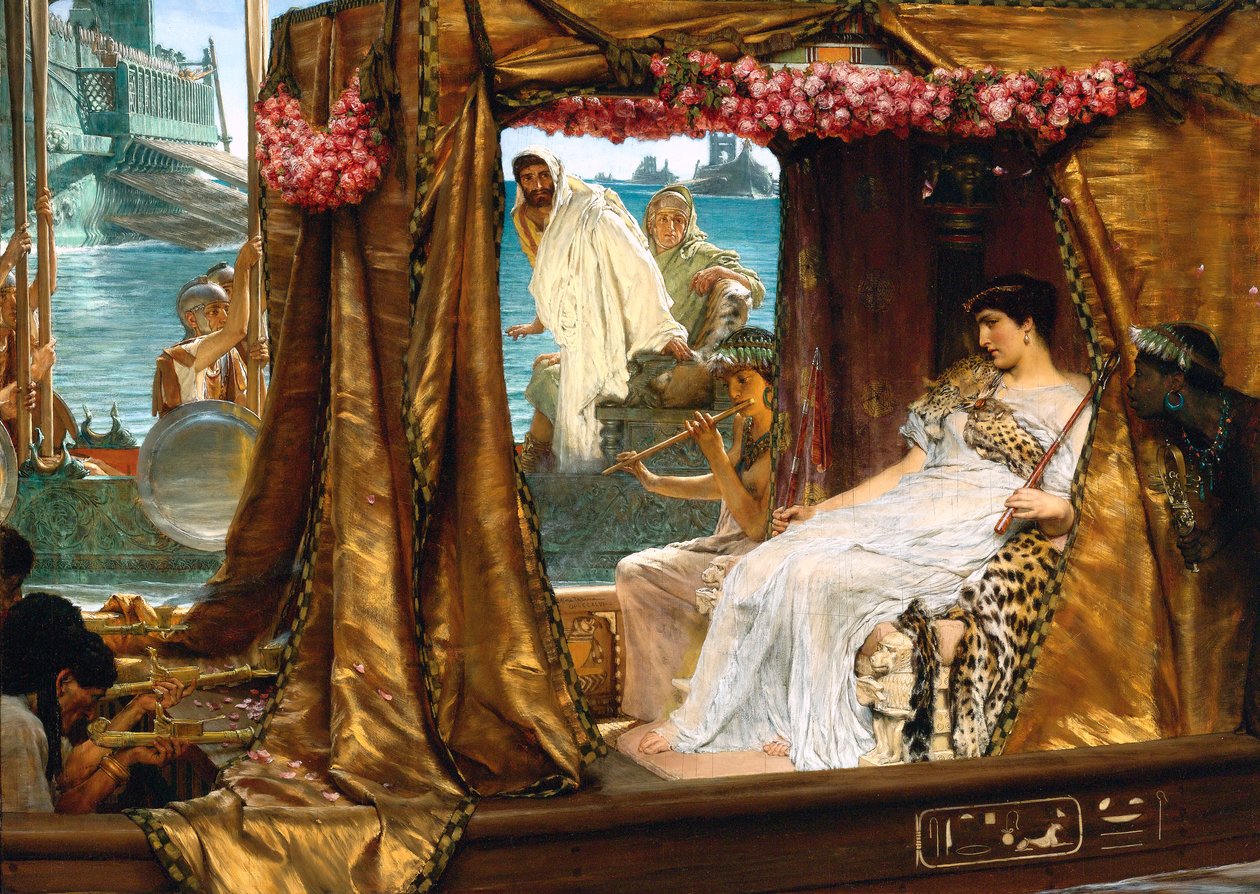1885 · Öl auf Panel
· Picture ID: 30869
Classicism
· Personalities · Famous Masterpieces
Lawrence Alma-Tadema (1863-1912) was a celebrated painter who had the great fortune to enjoy the favor of British Queen Victoria. With his passion for historical themes and exotic subjects, he satisfied the image hunger of his Victorian contemporaries. As a born Dutchman he also had Belgian and British citizenship. At the height of his success, he lived in London and was a member of the prestigious Royal Academy of Arts. No wonder the artist especially adapted to contemporary British tastes. When "The Meeting of Antony and Cleopatra" was first exhibited at the Grosvenor Gallery in London, one critic enthusiastically remarked, "The picture is incomparable."
The portrayal of the meeting between Antony and Cleopatra is based on a material of world literature: William Shakespeare had written the play titled "Antony and Cleopatra" around 1606/1607 and thus motivically followed his drama "Julius Caesar". Together with the 1608 subsequent tragedy "Coriolanus" form the three works of the so-called "Roman dramas". The historical models offered the poet space for exciting stories, dramatic developments and - as in this case - a tragic romance. The main characters of this love are the Roman general Marcus Antonius and the Egyptian queen Cleopatra. Although they both feel passionate love for each other, they divide political calculations and Antony finally enters a marriage of convenience with the Roman Octavia. A military defeat, in which Antony blames the Pharaoh, finally divides her completely. Cleopatra fakes a suicide, whereupon Antonius plunges into his sword. The act also heralds the end of the queen, who in the last, desperate act can be killed by a poisonous snake.
The picture shows the first, fateful encounter between Antony and Cleopatra. The latter arranged the meeting to win over the Roman general and politician. For this purpose, she drives in a bark, which the Greek historian Plutarch (about 45 - about 125 AD) knew to describe in the most beautiful colors: as a perfumed ship with purple sails, golden stern and silver oars , Lawrence Alma-Tadema captures the encounter with just as much talent for staging. In his interpretation, the Roman must content himself with a small section of the overall format. Like an image in the picture, he appears through the open pavilion, behind whose curtains Kleopatra eludes his undisguised curiosity. The proud woman is completely mistress of the scene. Leaning back she awaits the guest, from whom she promises influence in Rome and finally the consolidation of her power. As an unmistakable insignia of her regency, the painter has added the crook and the scourge to her. However, there can be no mistake about the outcome of the approaching romance: Cleopatra and Antonius contrast too sharply within the composition of the image to be able to imagine a "happy ending" here.
"The meeting of Antony and Cleopatra" fulfills the expectations of the late 19th century both in terms of content and technology. The Victorian era was generally focused on historical and, in particular, ancient themes. In addition, the painting also represents an example of popular Orientalism; a phenomenon in which the colonial power Britain had a significant share. The familiarity with the works of the national poet William Shakespeare could be presupposed anyway with the English educated bourgeoisie. But even those who did not know the story behind the picture could enjoy the picturesque quality. With attention to detail and fine brushstrokes, Alma-Tadema treats figures, clothes and the surrounding props in equal measure. Of course, behind all the splendor, there are already signs of decay. The petals scattered at the bottom of the ship testify to the transience of the lush garlands. Cleopatra's beast of prey is only a useless remnant of the noble wildcat - and not least a clue to her own miserable fate.
The Meeting of Antony and Cleopatra by Lawrence Alma-Tadema. Available as an art print on canvas, photo paper, watercolor board, uncoated paper or Japanese paper.
Other color variations of this picture
Other color variations of this picture
|
|
×




.jpg)
.jpg)
.jpg)
.jpg)
.jpg)
.jpg)
.jpg)
.jpg)
.jpg)
.jpg)
.jpg)
.jpg)
.jpg)
.jpg)
.jpg)
.jpg)
.jpg)
.jpg)
.jpg)
.jpg)
.jpg)
.jpg)
.jpg)
.jpg)
.jpg)
.jpg)
.jpg)
_Scene_de_debauche_dans_la_Rome_antique_-_Peinture_de_-_(MeisterDrucke-1320270).jpg)
.jpg)
.jpg)
 - (MeisterDrucke-67739).jpg)
.jpg)
.jpg)
.jpg)
.jpg)
.jpg)
.jpg)
.jpg)
.jpg)
.jpg)
.jpg)
.jpg)
.jpg)
.jpg)
.jpg)
.jpg)
.jpg)
.jpg)
.jpg)
.jpg)
.jpg)
.jpg)
.jpg)
.jpg)
 - (MeisterDrucke-116413).jpg)
.jpg)
.jpg)
.jpg)
.jpg)
.jpg)
.jpg)
.jpg)
.jpg)
.jpg)
.jpg)
.jpg)
.jpg)
.jpg)
.jpg)
 1873 - (MeisterDrucke-126917).jpg)
.jpg)
.jpg)
.jpg)
.jpg)
.jpg)
.jpg)
.jpg)
.jpg)







